Table of Contents
- Unlinked brand mentions are now critical for appearing in AI Overviews and search citations.
- “Building coverage” is replacing “building links” as the goal of digital PR for small businesses.
- Emotional, founder-led stories drive local and niche media coverage that AI tools increasingly cite.
- Proprietary or third-party survey data can earn citations when tied to trending or emotional angles.
- Publishing evergreen, data-rich resources (e.g., trend reports or indexes) attracts passive links and AI visibility.
- Strategic event sponsorships and podcasts amplify local relevance, boosting PR and AI search exposure.
I started my career working in marketing for small businesses. I found that they were often overloaded and cash-strapped, which was both a blessing and a curse.
It helped me stay laser-focused on how to get the best results for your money, but without someone who is in the weeds, you often miss out on many opportunities.
PR was often overlooked, but with recent developments in AI, it has risen to the top of many small businesses’ priorities.
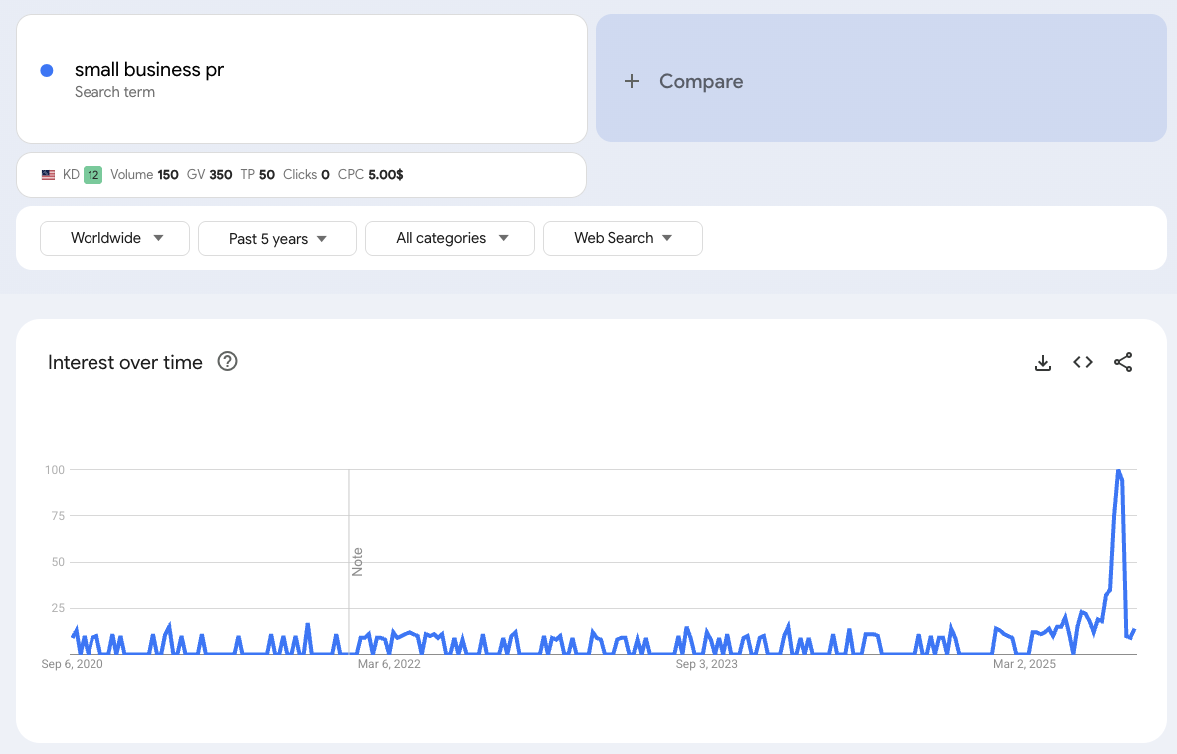
In this post, I’m going to outline some of the key ways that small businesses can use digital PR to get coverage online, build brand awareness, and show up in AI citations.
Why is digital PR more important than ever for small businesses?
Digital PR used to be closely tied to link building and SEO. While it is still tied to links, unlinked mentions are becoming increasingly crucial for appearing in AI citations.
So, digital PR is starting to look different.
One of the significant studies released this year by Ahrefs revealed a strong correlation between brand mentions and appearing in AI Overviews.
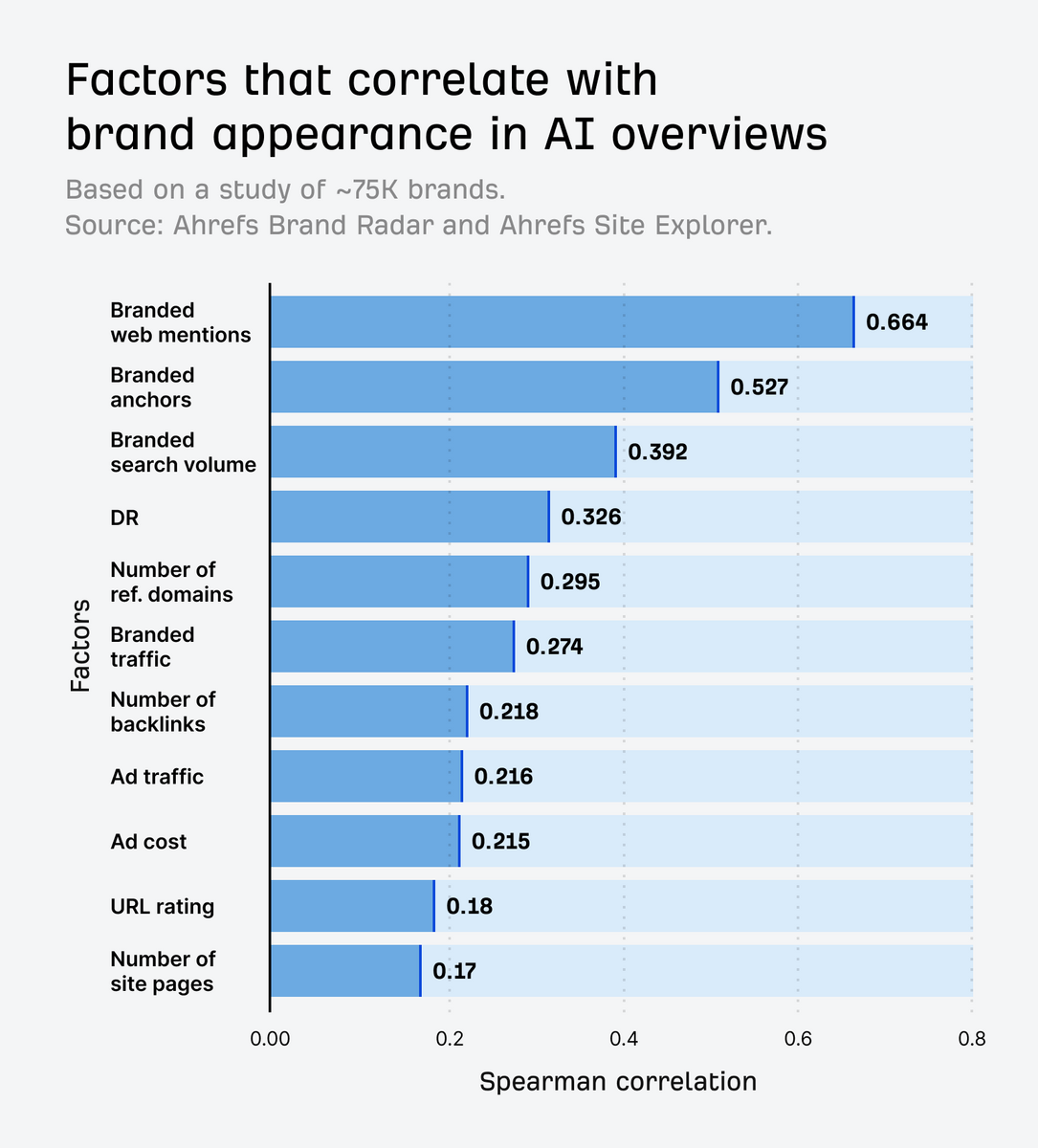
So, building a brand, whether big or small, has become increasingly important if you want to appear in AI Overviews.
Backlinks still matter, but brand mentions are more important than anything else.
Thus, I’ve started using the term “building coverage” instead of “building links” when discussing PR.
With that in mind, here are nine tactics for small businesses to get in the news and win coverage.
1. Tell Stories About You or Your Business
Every business and founder has a unique story. It may not even be able to do the business itself. It might be about the person behind the idea or the story behind the company’s formation.
These stories can become the basis for coverage and links to your business.
Army Vet and Extreme Marathoner Launches a Startup
Here’s a story from GeekWire about a startup built by an Army vet and extreme marathoner.
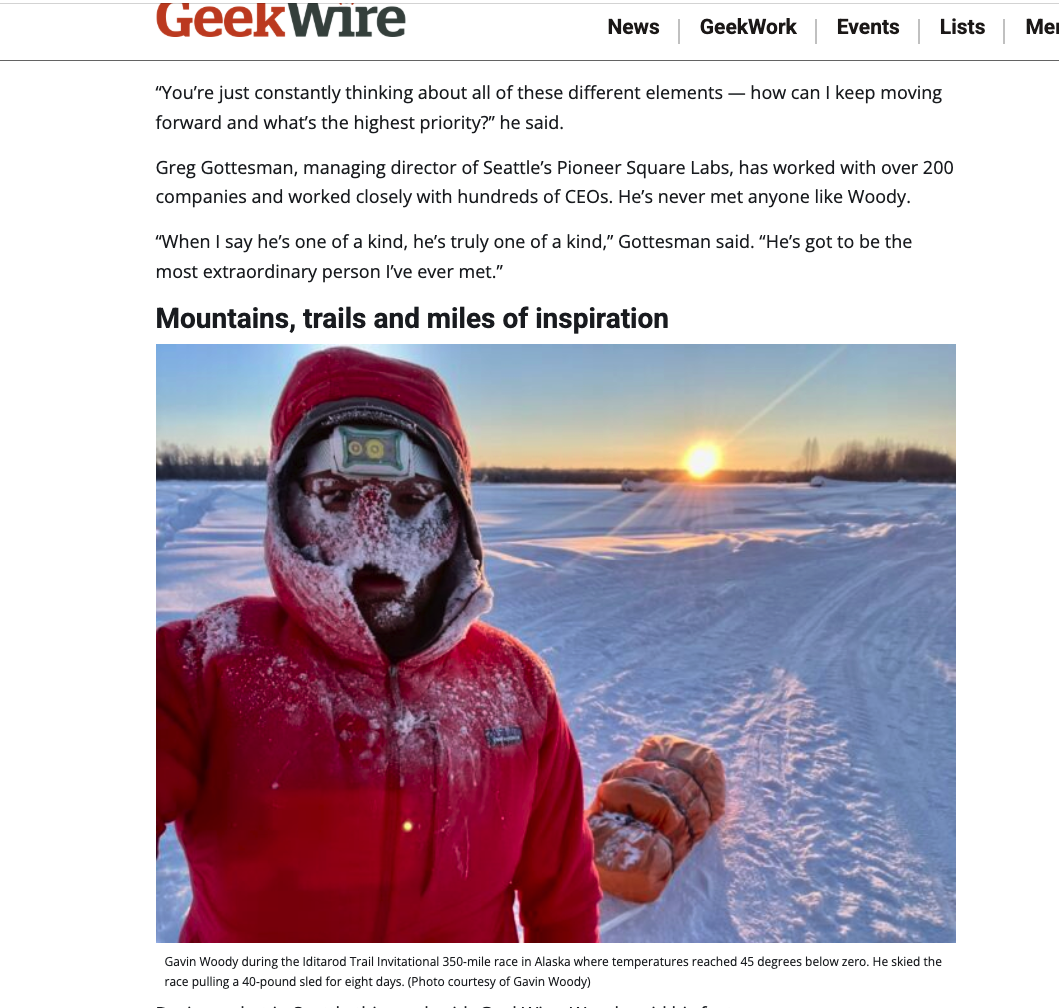
This is part of an ongoing segment that covers the Pacific Northwest startup scene. It’s lines like this in a story that can help any new business stand out:
“Earlier this year, Woody completed Alaska’s Iditarod Trail Invitational, a 350-mile ultramarathon on the famous dog sled course.”
But not all stories need people who run marathons to get coverage. Let’s look at some more.
Fat Peach Bakery
A bakery in Chicago’s South Side got coverage from the Eater. The story, however, digs into the founders’ roots and inspiration.
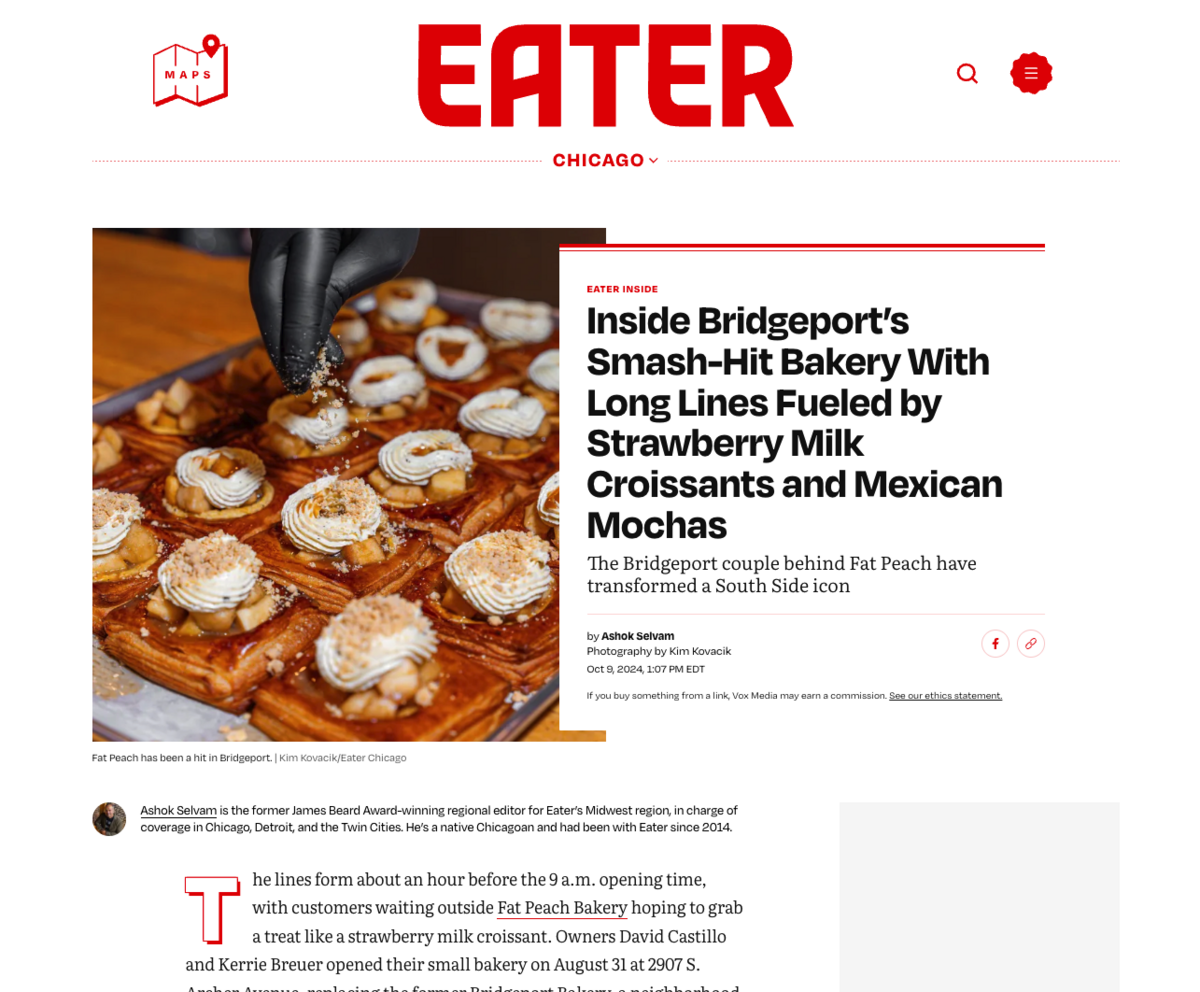
As you can see, the hook is in this line:
The two met while working together at a Chicago bakery. Castillo, a Mexican American, grew up in suburban Blue Island. Breuer grew up in North Dakota after being adopted from South Korea.
Castillo visited Mexico City as a child, and the bakeries there — using simple ingredients and techniques — left an impression. He wondered why he couldn’t find similar pastries in Chicago.”
This is where a simple bakery opening announcement goes from good to newsworthy.
Charhause Cookie Opening
In another example, the CTInsider covered a bakery opening in Bolton, CT.
The hook here is evident right in the headline: a Connecticut native leaves corporate job to open a bakery.

It also serves as the opening of the article:
“After deciding that the corporate world of insurance was not for her, Kate Cofiell took a leap of faith and began the steps last year to open her own business—a bakery and cafe called Charhouse Cookie, located at 299 Boston Turnpike.”
This connection with Connecticut, along with an inspiring story, helped secure placement in a prominent local news publication.
How to do it:
Find the stories between the lines.
Interview owners, customers, and employees to understand the stories behind the brand.
Put yourself in the journalist’s shoes and always try to answer: so what?
Another store opening or business starting isn’t something to cover.
Dig deeper.
If you are covering someone who started a small business, what were their motivations? Do they do anything interesting outside of their business?
Look for stories that inspire emotion. As you will see, this idea of emotion runs through most of the content you want coverage for.
Who to Pitch?
Typically, these stories are covered locally or by niche publications (or both).
For instance, the ultramarathoner/army vet Gavin Woody, mentioned above, also got coverage in Outside Magazine’s blog:

But here he is mentioned in San Diego by Fox5:
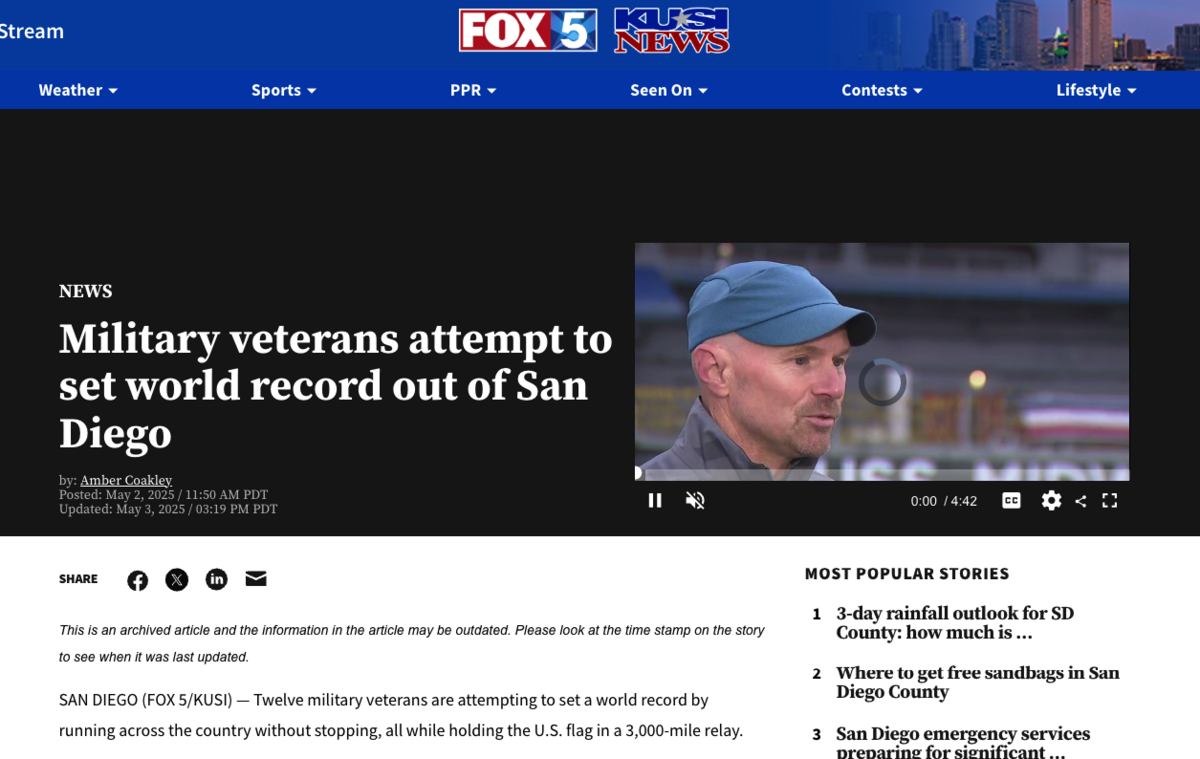
When pitching to industry-specific sites, most journalists or editors will do.
When pitching to local news, look for those specifically covering the local beat.
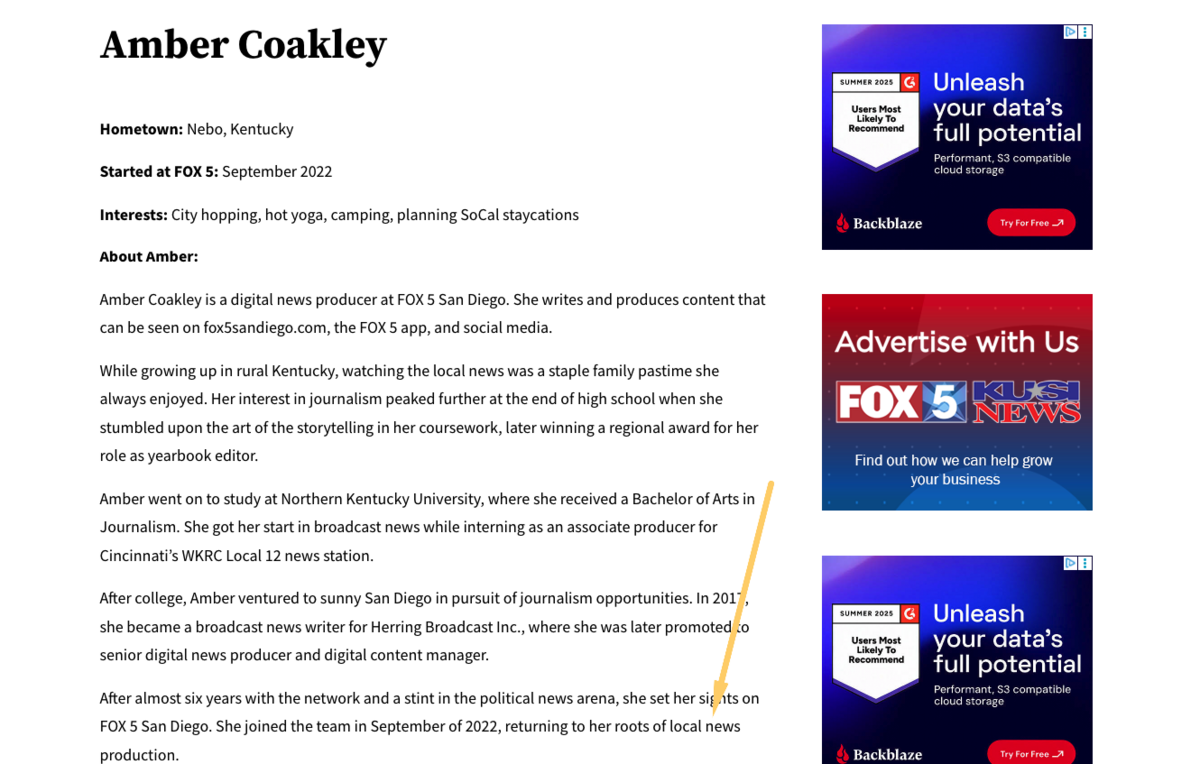
Typically, local news journalists who cover this sort of thing will also cover events. Be sure to read bios and look at recent coverage.
You can also try searching by the type of coverage you are looking for. For instance, if I were trying to pitch a startup in Portland, I’d search:

This will help uncover journalists who may be more interested in the kind of story you want to pitch.
2. Tell Stories with Proprietary Data
Proprietary data provides journalists with precisely what they are looking for: something new and fresh.
All data has a story. The kinds of stories that resonate with readers tap into emotion and are timely.
These emotions can range from surprise to anger, to fear, and frustration.
Most companies have access to some sort of internal data. The trick is to publish it in a way that is digestible and interesting.
Here are some examples:
Slice’s Pizza Index

Slice’s Pizza Index is part of a larger project called the Slice of the Union, which presents a comprehensive report on how Americans consume pizza, based on their proprietary data from users over the past year.
Slice isn’t actually a small business these days, but there are a lot of great ideas to take away from this big study.
All proprietary data has a story to tell—even pizza. The Pizza Index is a proxy for the national economy (Slice’s take on the Economist’s Big Mac index).
The Pizza Index was actually featured in sites like Crain’s and CNET, and the complete study garnered coverage from notable outlets such as Axios, Food & Wine, and local news sources like Cleveland.
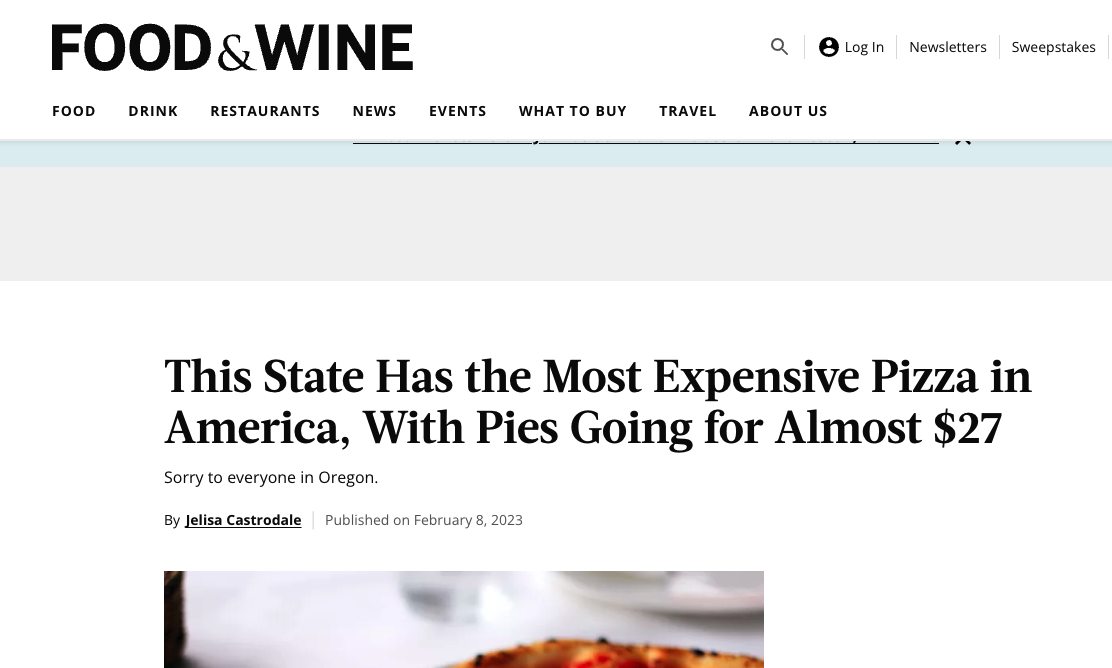
But the whole Slice of the Union has many different angles and stories all taken from their proprietary data: favorite toppings, most “pizzaful day”, cities with top pizza sales, and more.
Grubhub’s Soup Requests
Back in 2016, when Grubhub was still relatively small, they conducted a study that always stands out in my mind.
They compared their data with Zocdoc’s data to show that soup orders increased each year during cold and flu season, as reflected in Zocdoc’s usage.

This study was prominently featured in The New York Times’ Upshot and in many other news outlets at the time.
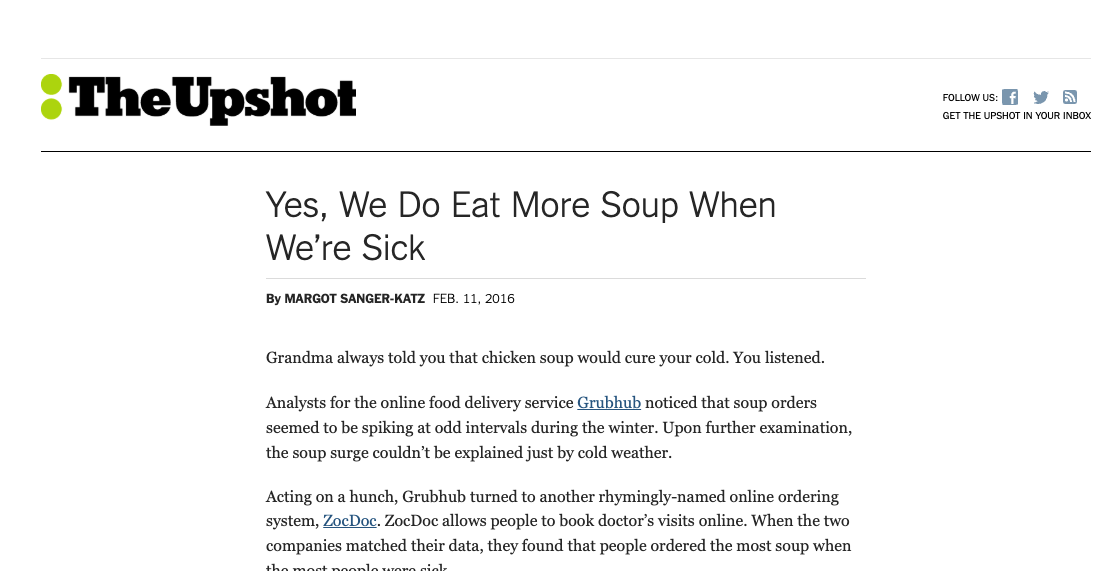
How to do it:
There are several ways to generate ideas, including starting with your own data or competitor content.
If you don’t have many resources, I recommend using ChatGPT as your guide.
Feed ChatGPT your data and ask it to help extract insights that may elicit some emotion. This works surprisingly well.
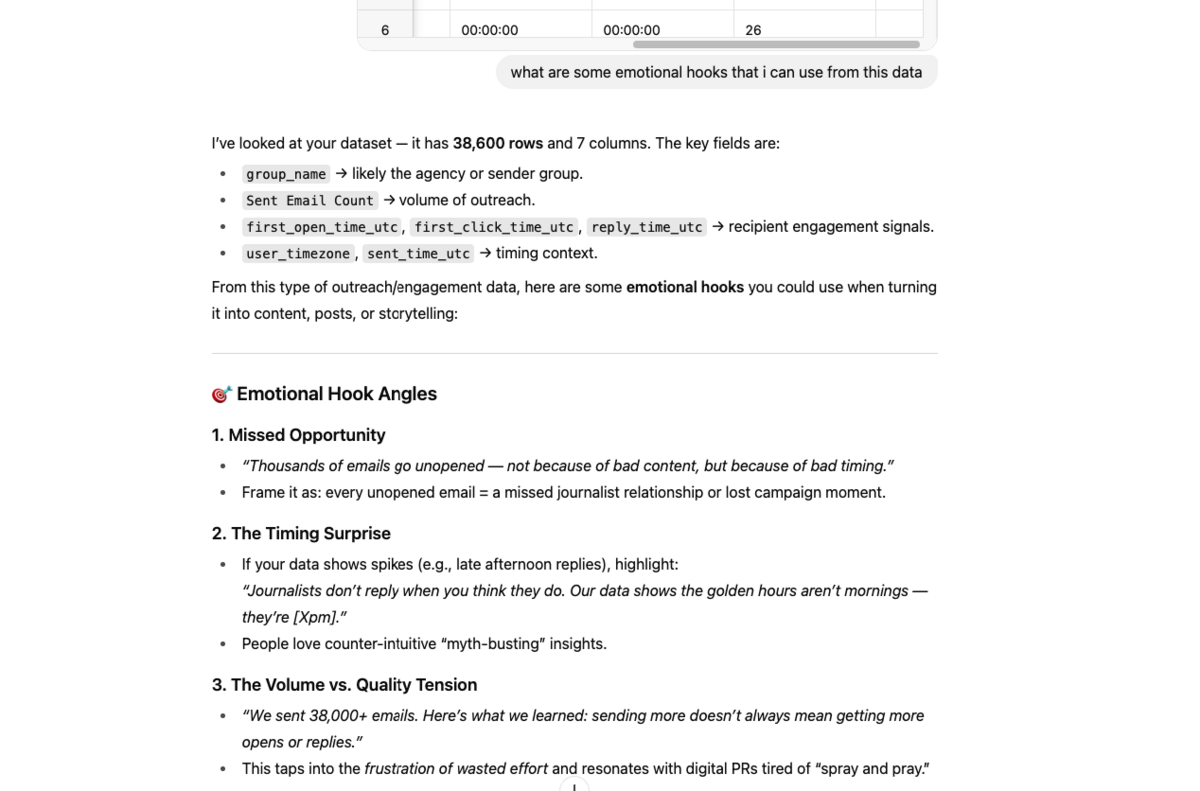
Then, use a tool like Canva or Infogram to visualize the data.
All of these tools I mentioned are explained in more detail in my PR tools post.
Who to Pitch?
It’s definitely about finding the right fit from an industry perspective. But then you need to drill down to make sure the writers share third-party data.
For instance, the Pizza Index was covered by a freelancer who covers mostly food-related topics.
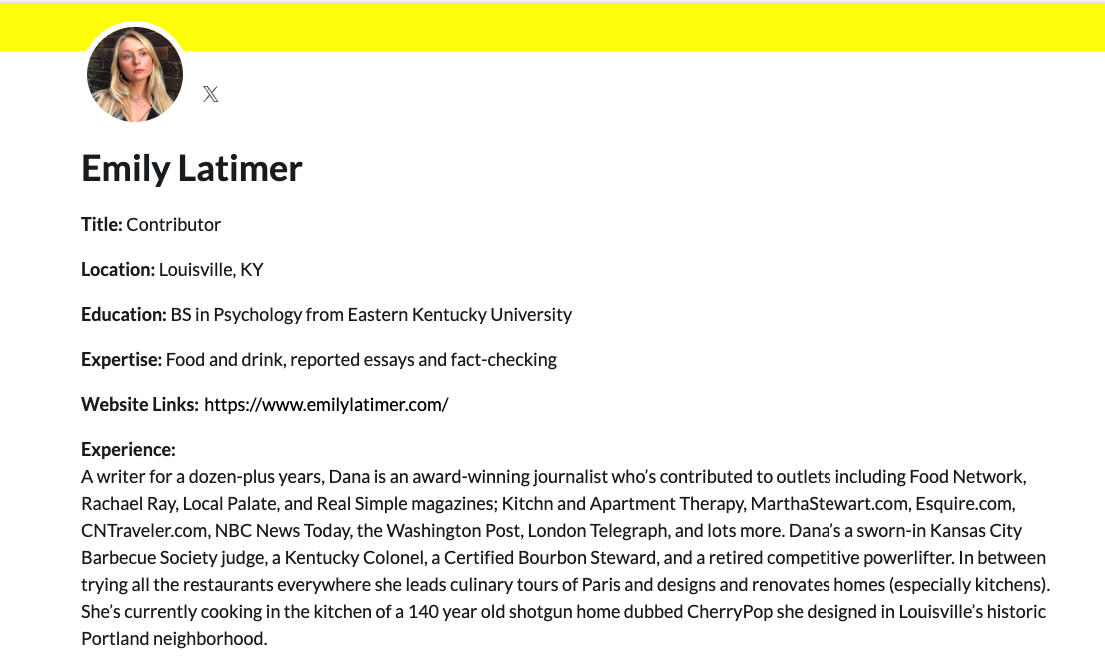
As you can see, she also shares data-led stories:

It’s all about hyper-targeting your pitches to the right journalists.
3. Publish Data to the Public as a Resource
As above, proprietary data can be published as a resource available to journalists and researchers writing about the topic. This is known in the SEO world as “passive link building”.
The idea is to create a resource that aligns with a term a journalist will want to search for (either on Google or in an AI chat) and cite in an article they are researching.
These are terms like:
- X Statistics
- X Trends
- X Data
Say you are a local car dealership; you may have data on which inventory sells the quickest.
What are the most popular colors of cars that have been sold?
Are there certain times of the year that are more popular than others for buying cars?
All of these kinds of statistics make for great nuggets of information for journalists.
iSeecars Best Family Cars
Here is iSeecars’ ranking of the best family cars, based on its own data and methodology to create a “Family Car Score”:
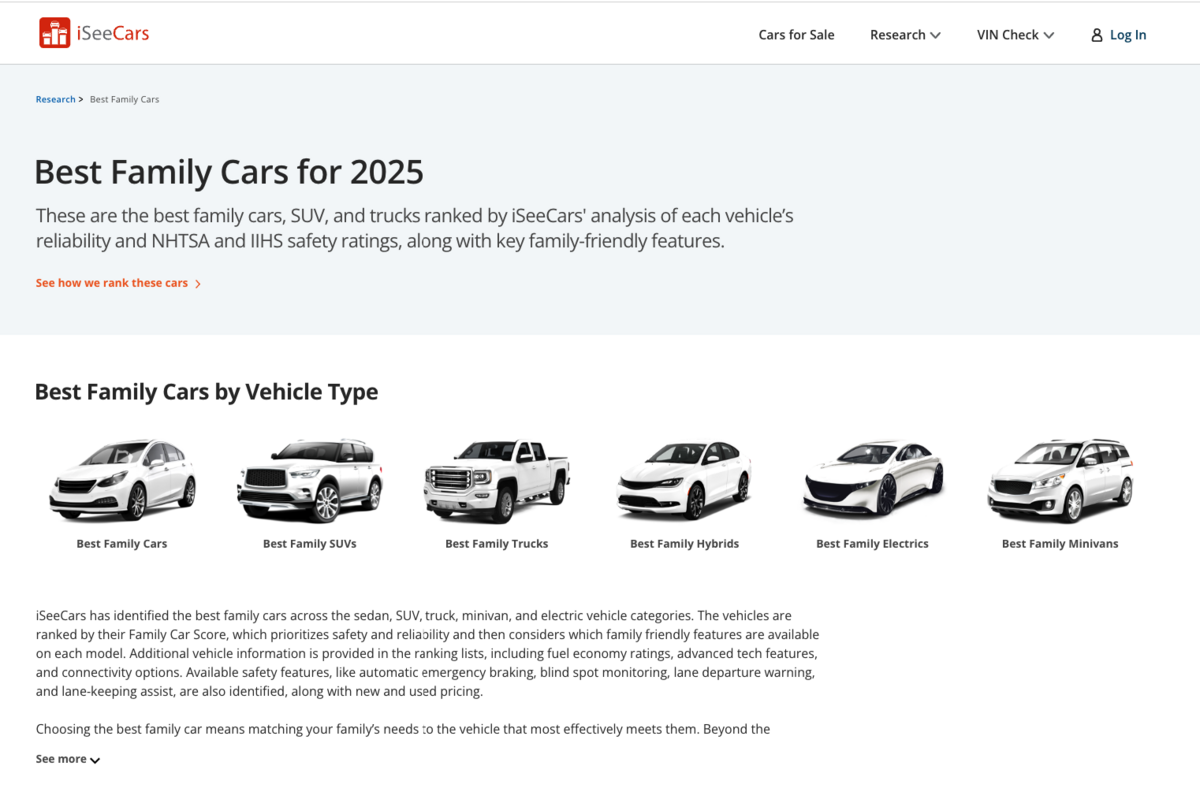
This kind of data eventually got written up by publishers like USA Today, specifically calling out the Family Car Score:
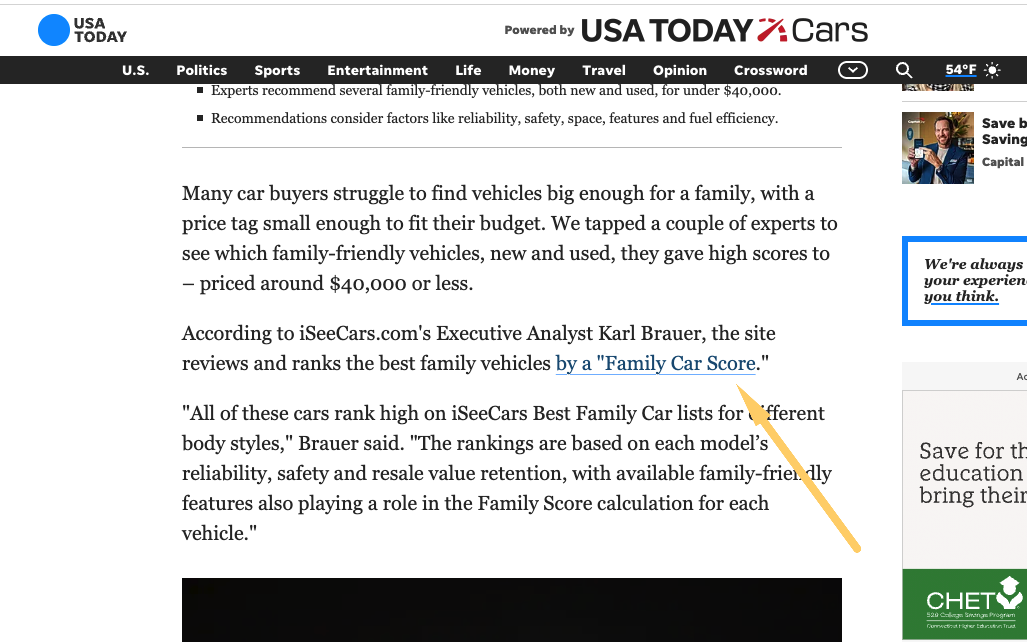
This proprietary scoring system builds trust and helps stand out. But the data itself is something everyone can use.
Clio’s Legal Trends Report
Clio has been publishing legal trends reports for almost 10 years.
Their first was published in 2016, back when they were relatively small. It gathered data from over 40,000 attorneys and helped establish industry benchmarks.

Fast forward to 2025, and they have broken it into various-sized reports.

This content gets cited all over the place online, from extremely relevant, authoritative sites like the American Bar Association:

But it has also garnered news coverage from Yahoo Finance and others.
Unsurprisingly, it also ranks well for keywords around “legal trends.”
This is the kind of tactic that has gotten them repeat links.
Backblaze’s Hard Drive Reliability
Backblaze has been publishing its Hard Drive Life Study for over 12 years. They’ve even written a great post on how the strategy has grown.
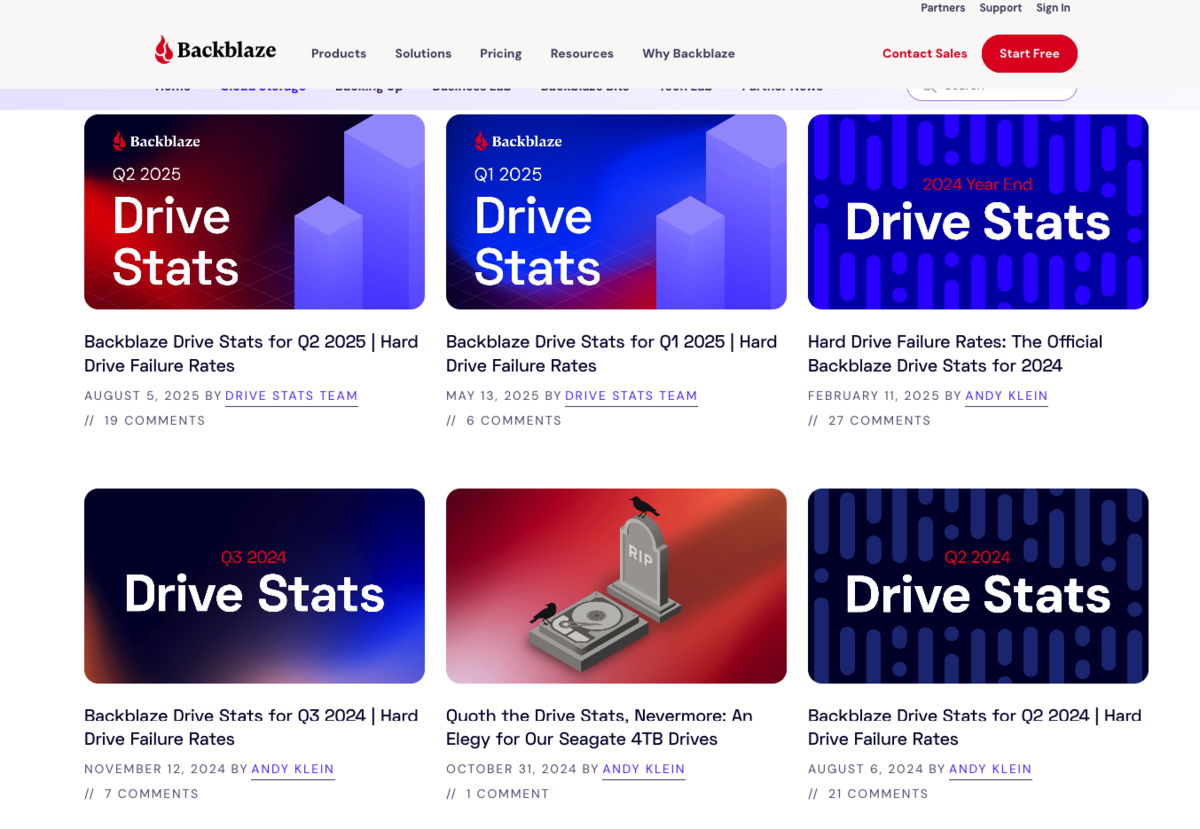
The stats pages cover information such as the number of hard drives and their failure rates. They even have data available to download.
This kind of data has helped them rank for keywords related to hard drive reliability, so whenever someone Googles the term, their data is ready for them.
How to do it:
Look for internal data that can be replicated monthly, quarterly, or annually.
Present it in a way that journalists or researchers can easily find, typically in a blog post.
Your site usually needs to have a higher domain authority to rank for these keywords, but today we are seeing keywords with lower authority appearing in AI citations.
Be sure to include helpful graphs, images, and statistics that would be interesting to any research covering the topic.
For more on this strategy, see our passive link building post.
Who to Pitch?
Typically, you don’t need to “pitch” this type of information as it exists for journalists to find. That said, it cannot hurt to pitch if your data is interesting.
The same principles apply here as in the previous tactic: you are looking for journalists who cover third-party data.
4. Get Survey Data From Third-Party Platforms
Technically, this is still proprietary data. But not all teams have access (or time to access) their user data. The second opportunity here is to use a third-party data source to collect your own survey data.
Platforms like Pollfish, SurveyMonkey, and YouGov offer self-service survey capabilities that enable you to get started, craft questions, and gather answers with minimal effort.
Let’s look at some.
Lumicera Pharmacy Poll
Lumicera is a smaller business in the pharmacy space. They used Pollfish to conduct a survey and publish a study on people’s interactions with pharmacists and costs.
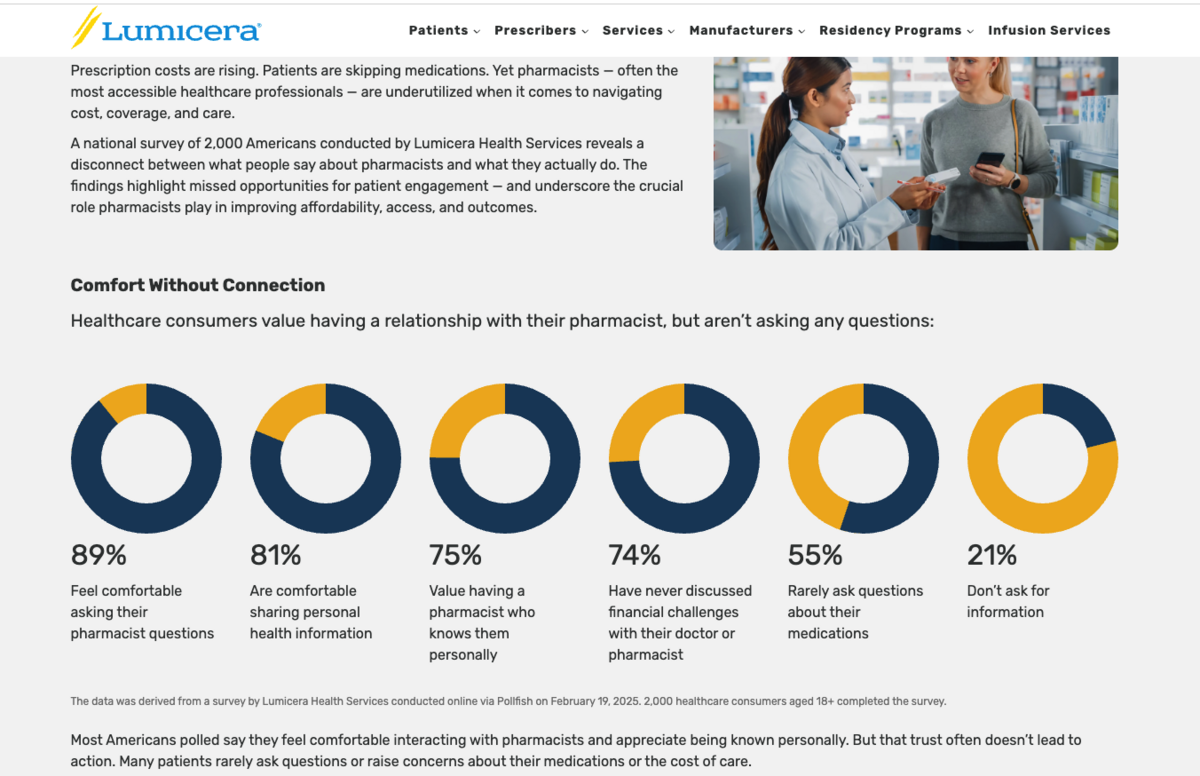
As we found in our YouGov study, emotional hooks can significantly help these posts get shared and picked up by journalists.
Lumicera taps into curiosity with their headline, and the data itself presents the frustration involved in pharmacy interactions:

When it got covered, we can see that journalists from relevant publications gravitated towards these emotional hooks:
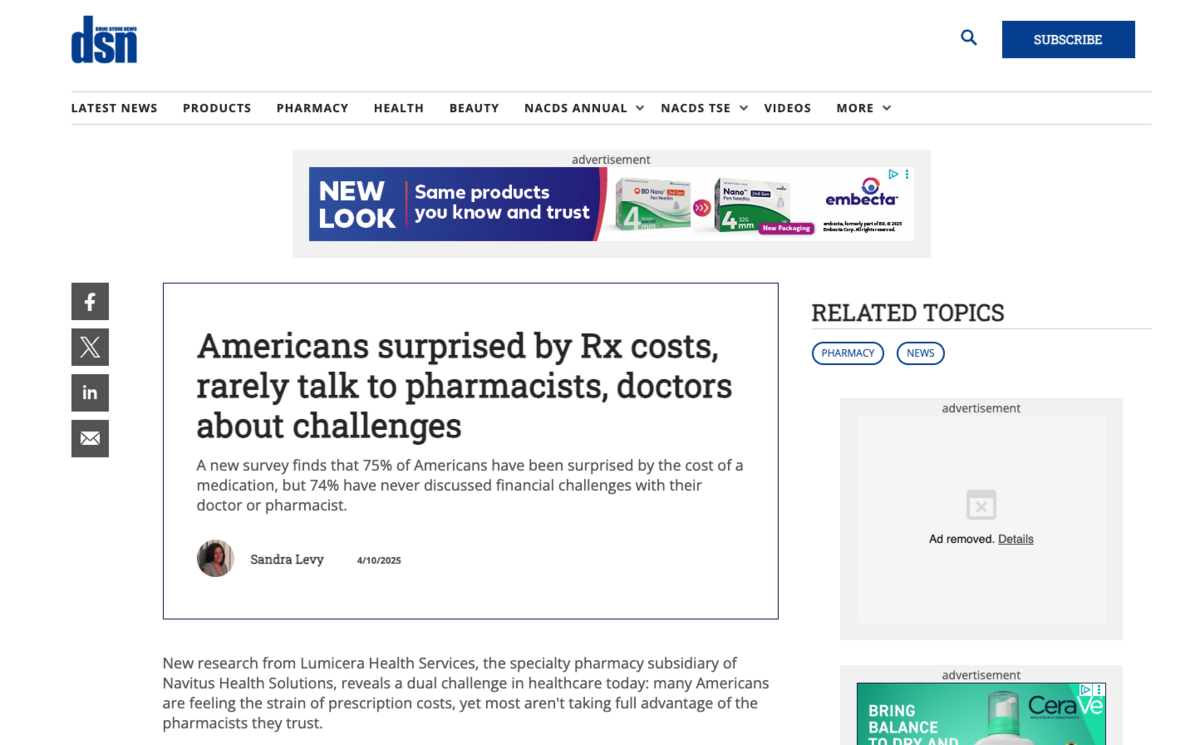
However, it’s not all about emotion; timeliness plays a part as well.
Verra Mobility Distracted Driving Survey
Here’s a survey from Verra Mobility around distracted driving.

Verra Mobility offers “smart tech” mobility solutions, so the connection to driving is clear.
For the survey itself, they leaned into emotions like fear and danger associated with distracted driving.
Then, the timely hook is that it was launched during Distracted Driving Awareness Month.
Ultimately, it yielded coverage in relevant industry publications, such as Fleet Owner:

Clearly, the coverage leaned into both the timely hook and the fear of distracted driving.
How to do it:
You can get survey inspiration anywhere, really, but you can start by looking at what the news is covering in publications you wish to get noticed by.
Then, work backwards from the headlines and the kinds of stories they cover. This will give you a head start on creating content that a journalist may want to cover (or not cover).
For instance, if I wanted coverage from CBS News, I could do a site search for the word “survey” and find several surveys they’ve shared around money and work:

Analyzing these will help craft the questions found in the survey itself, leading you towards headlines that can get clicks and shares.
If you’re interested in learning more, we have an entire post on ideating survey content.
Who to pitch?
Here, you are looking for journalists who have covered other third-party survey data.
You can do some searches online for something like:
Industry + ”survey finds”
Industry + ”data finds”
But you should also look at recent articles by journalists to ensure they are sharing third-party data. For instance, the author at FleetOwner, who covered the distracted driving piece, looks to cover third-party data frequently:

Also here:
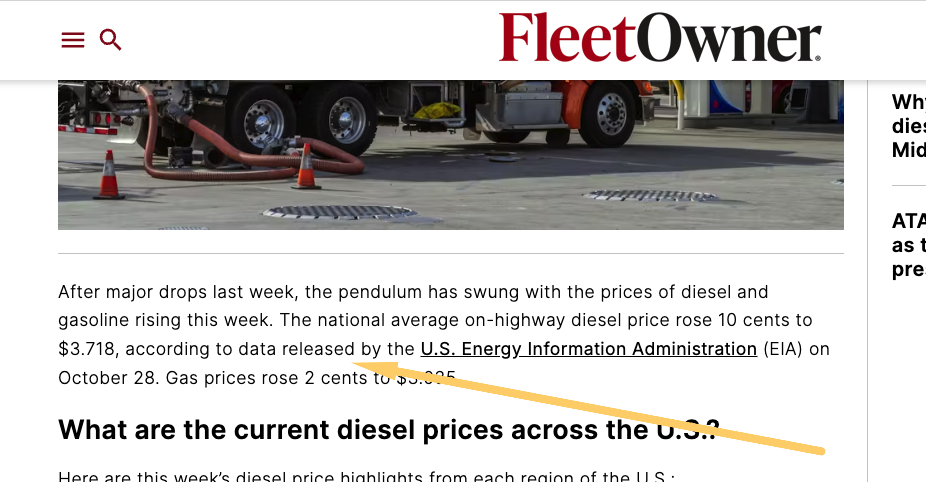
These are positive signals that they would be open to sharing a data-led story from you.
5. Respond to Journalist Requests
Responding to journalists directly is one of the best ways to increase the odds of getting coverage.
Journalists often request quotes from experts via social platforms like X, email services like Source of Sources (SOS) and Help a Reporter Out (HARO), or quote request platforms like Qwoted.
For example, if you search for #journorequests on X, you’ll find a list of journalists actively asking for new quotes:

In these cases, you directly email the journalist with the requested information.
Note, based on our study, we found that most of these requests come from UK-based media sources.
SOS and HARO are email digests with requests that come in on a daily basis:
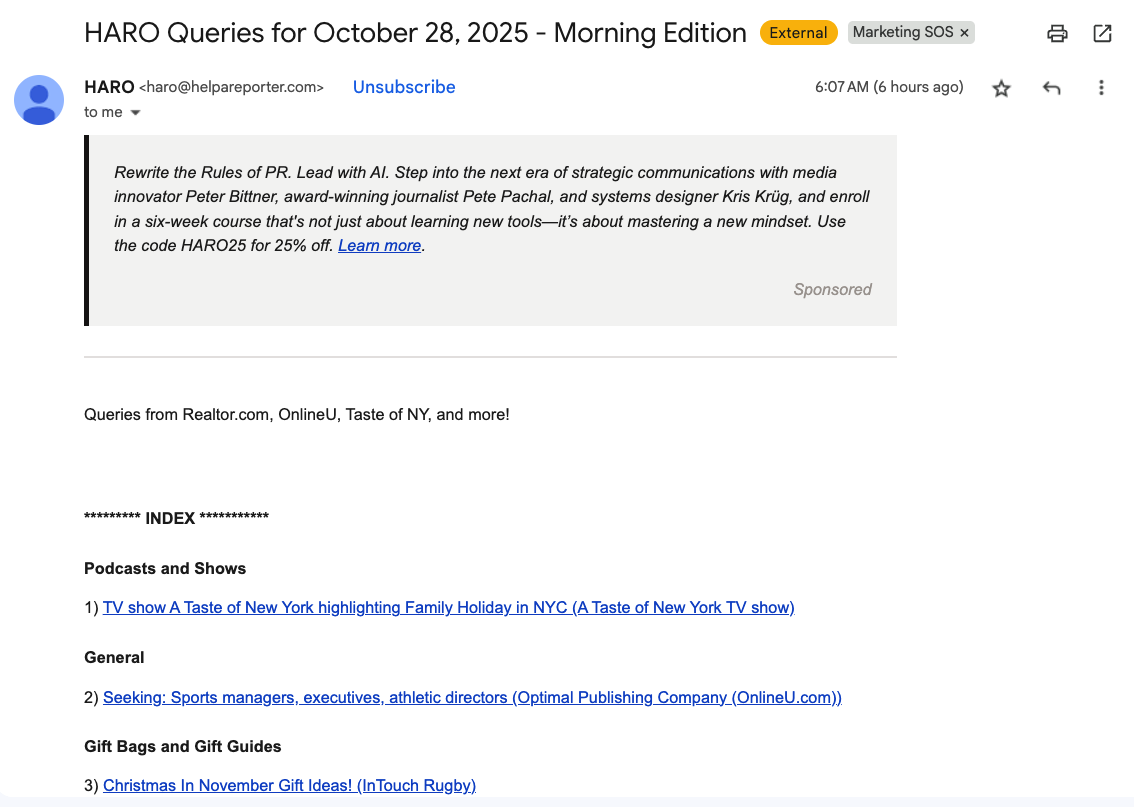
When clicking into them, you can see more detail about each request.
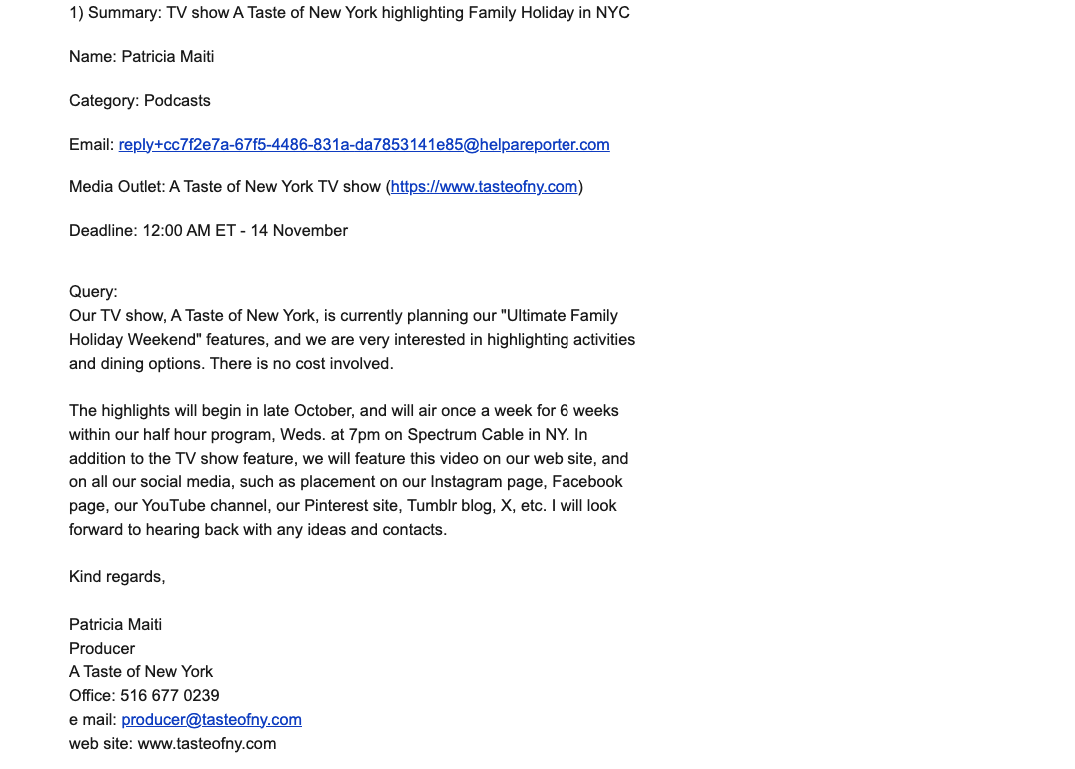
Some outlets, like Qwoted are actual platforms which allow you to go in and search for requests from a database:
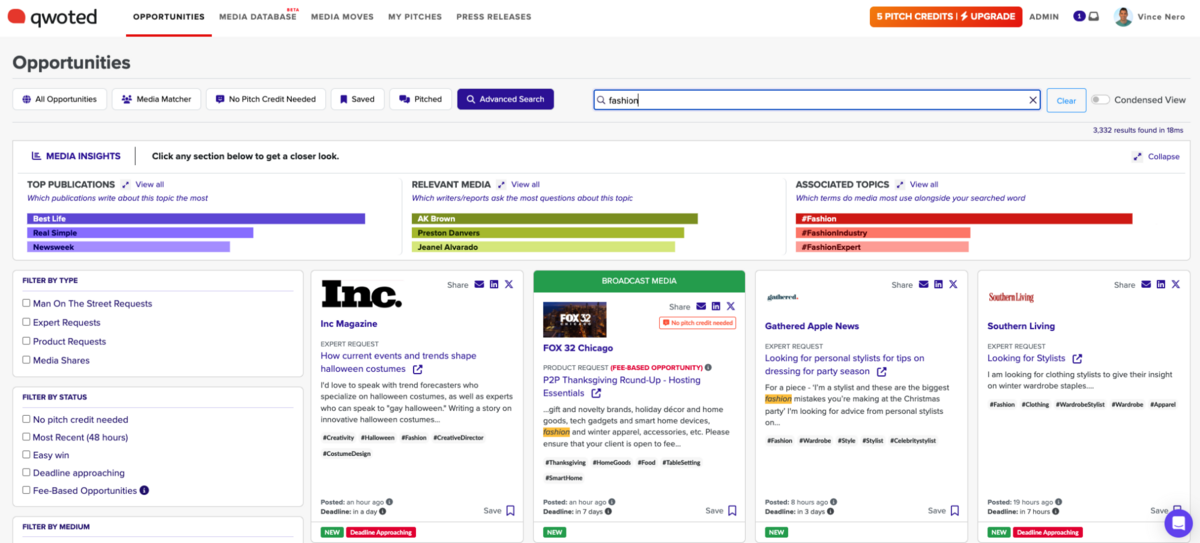
These kinds of placements end up as coverage in the various outlets.
How to do it:
Sign up for X, Qwoted, SOS, and HARO requests.
Then, create a daily workflow that monitors relevant requests. (Or sign up for a tool that aggregates these, like PressPulse.
IMAGE
When responding, never use AI as that will most likely always get you blocked, marked as spam, or kicked off the platforms.
We gathered helpful tips from the platform owners themselves on how to successfully find respond to relevant journalist requests.
Know that just because you respond doesn’t mean you’ll definitely get covered. You are vying for attention from all of the other PR pros and brands on these platforms.
Who to pitch?
Depending on where you look,
The other option is to introduce yourself to journalists so that they reach out to you directly. Let’s look at that next.
6. Introductions to Journalists
Of all the guests I’ve had on our podcast, one of the recurring recommendations from PR pros is to introduce yourself to journalists at the onset of starting a PR position or new client.
Essentially, you are proactively letting them know who you are and why you (or your brand/client) are important to them.
For instance, Amelia Selby, Head of PR at SEOTravel told me:
We are always “putting some feelers out to say, ‘Hey, I know you often like, you know, insight from experts. These are my experts. If you ever need any support, I’m here, potentially sending through a few quotes.’
We’ve established really good relationships just by doing that.”
Check out our whole podcast about PR on a small budget.
Further, Domenica D’Ottavio , PR Director at Journey Further, told me they do media intros fairly often.
“Introducing yourself to a journalist without pitching is one of the best long-term relationship builders in PR. It’s not to sell a story, but to say hello, show we understand their vertical, and let them know we can be a helpful resource when the right story comes up.”
“It’s short, personal, and service-minded. Typically it’s personalized. We don’t send out loads and loads of media intros, we only select for the most relevant journalists. This sets a tone of helpfulness, and ensures we know their beat inside and out. We’re hoping to create a natural way to follow up later with a relevant story.”
How to do it:
Find key journalists that you wish to get coverage from. You can do this by simply doing a Google News search around your industry.

Read through their stories and see if they provide quotes from experts within the industry.
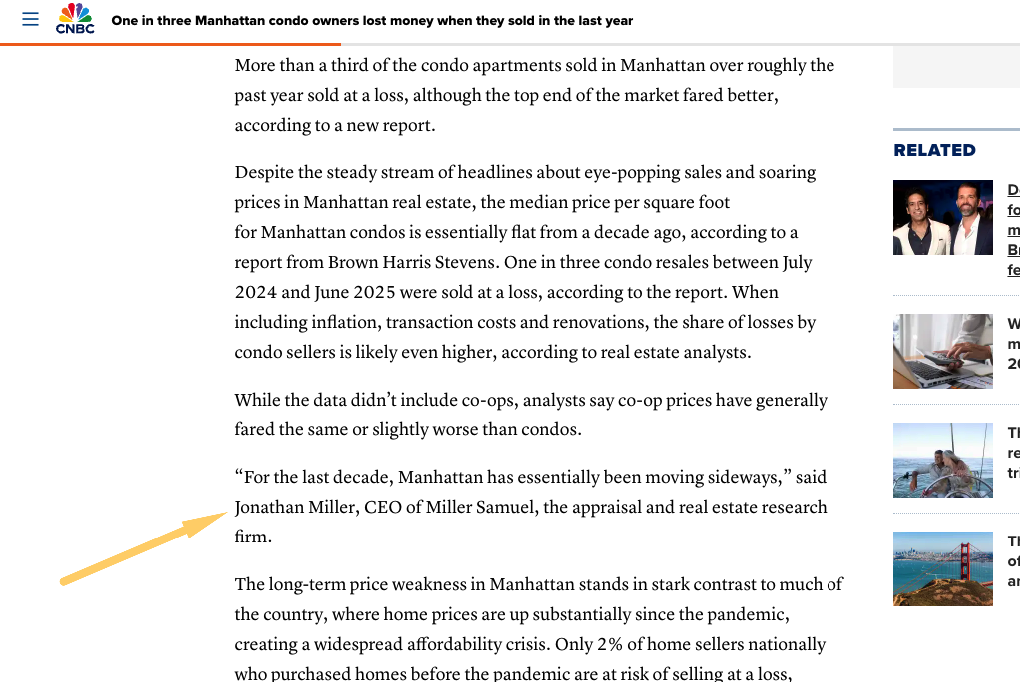
Then, you’d pitch them something like this:
Hi [First Name],
My name is [Your Name] and I’m the [Your Title] at [Agency/Company Name].
I work with clients in real estate sector and will often be working on story ideas or commentary that align closely with your beat.
I wanted to introduce myself so you have a point of contact when you need sources, briefing, or commentary down the line. No immediate ask, just glad to connect and stay on your radar.
Thanks.
The idea here is not to pitch, just to let them know you’re available as a resource.
7. Putting on Live Events
Some folks I talk to don’t consider events as part of PR—and definitely not part of “digital” PR. But this is a missed opportunity in my opinion.
These events can not only get you in front of your key demographic, but can also get you on news publications and high authority websites.
Small Business Week City Hall Pop-up Shop
Here’s a pop-up shop event that’s happening during Shop Dine SF. It features almost 50 local businesses at San Francisco’s City Hall.

Participating in events like these not only gets them facetime with customers, but they can also yield high-value online coverage.
For instance, here’s a post from SF.gov, a DR 84 site, that covers the pop-up shop. Each of these small businesses gets a valuable link back to their website.
Crafty Atrium Popup Shop
The Crafty Atrium is a monthly popup shop that happens in the Embassy Suites in Laredo, Texas. This event brings in local shops and brings tons of exposure not only to the brands in the community.
Then, it gets coverage from local news, like the Laredo Morning Times.
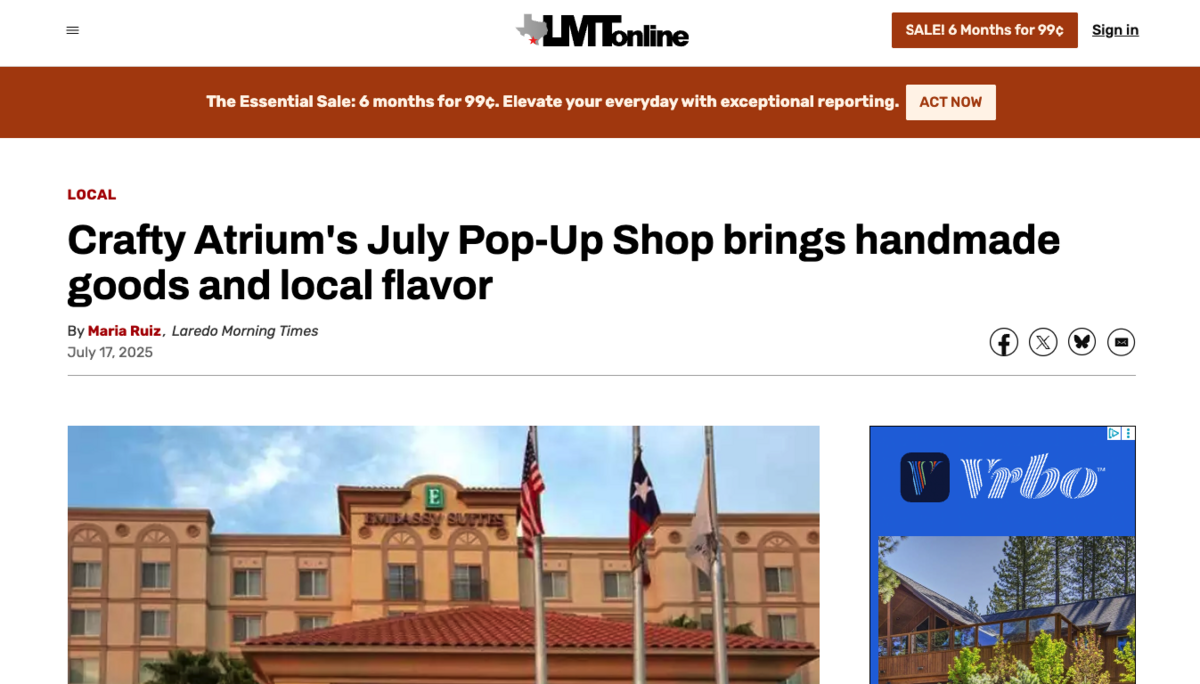
Who covered this?
An events and breakding news reporter.

Two Cheezy Guyz Charcuterie Workshop
A local food shop in Michigan, Two Cheezy Guyz, put on a charcuterie workshop as part of their annual Festival of the Arts.
This gives their team a chance to showcase their knowledge and build trust with potential customers.
Secondly, it got them coverage in a local newspaper, which, for a small business, is like gold!
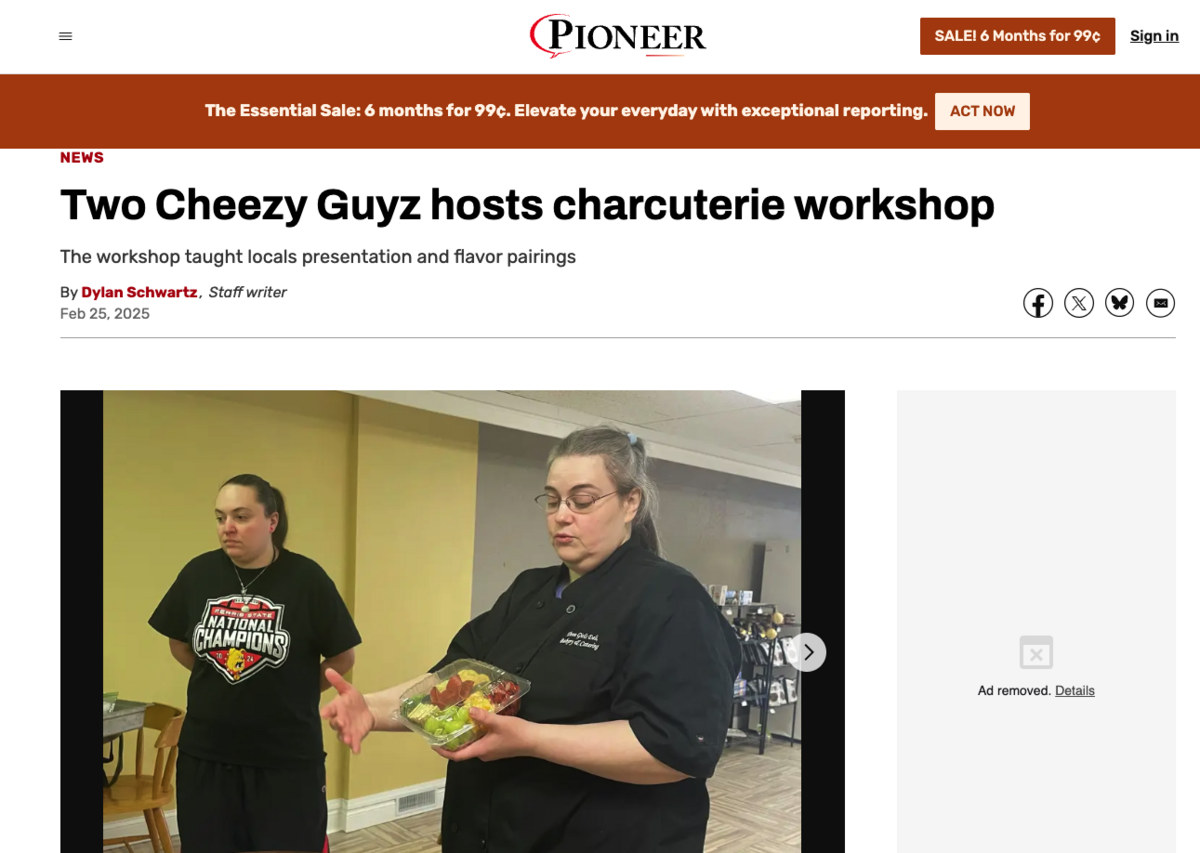
How to do it:
For live events to be effective, you need to partner with the right people and places. One of the easiest ways to do this is by looking at where your competitors are doing it.
Additionally, you can try searching for live events in your area. Most towns have farmers’ markets, seasonal events, and holiday-related events that are perfect for live booths.
Who to Pitch?
With live events, you are typically looking for journalists who cover local events.
For instance, the journalist who covered the charcuterie workshop covers the “arts and entertainment” beat.
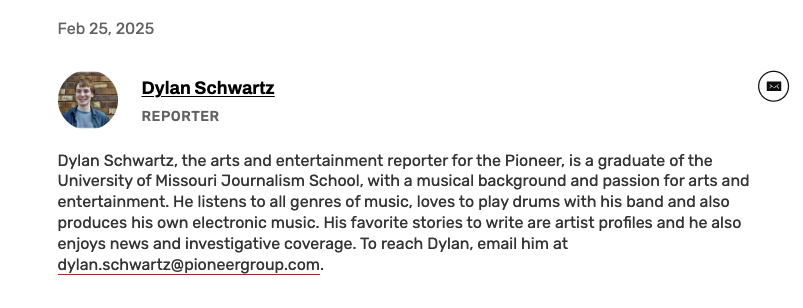
But we can also confirm that he covers local happenings when looking at his recent articles:
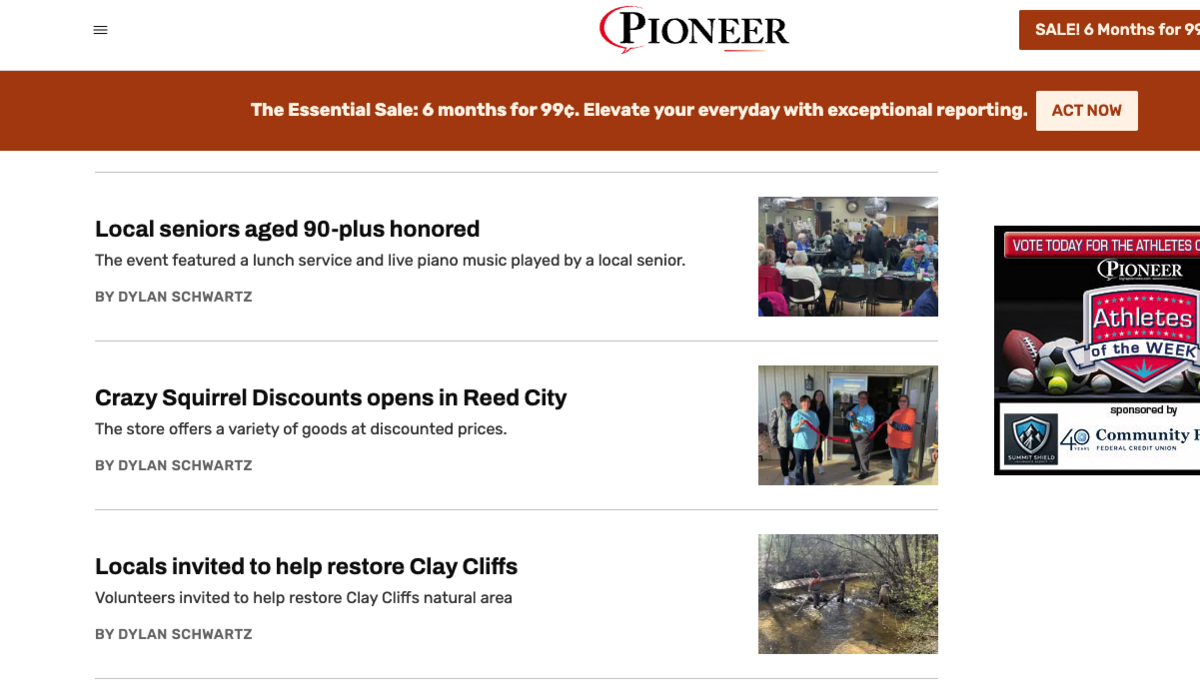
These two signals should get to the right journalists.
8. Sponsoring Events or Charities
Aside from being genuinely positive, sponsoring local events and charities is one of the most effective ways to engage with actual customers.
These events often feature high-authority sites and/or receive write-ups from high-authority news outlets.
So, they make great PR plays for small businesses.
We spoke to Chris Brencans, founder of OntheMap, a local marketing agency, on our podcast about this. He said, “A more evolving trend in local SEO is community outreach and participation in community events because Google wants to see some local signals that you’re a real brand.”
Here are some examples:
Free Uber Rides from Pemberton Personal Injury Law Firm
Pemberton Personal Injury Law Firm partnered with Uber for Business to provide free rides on the Fourth of July.
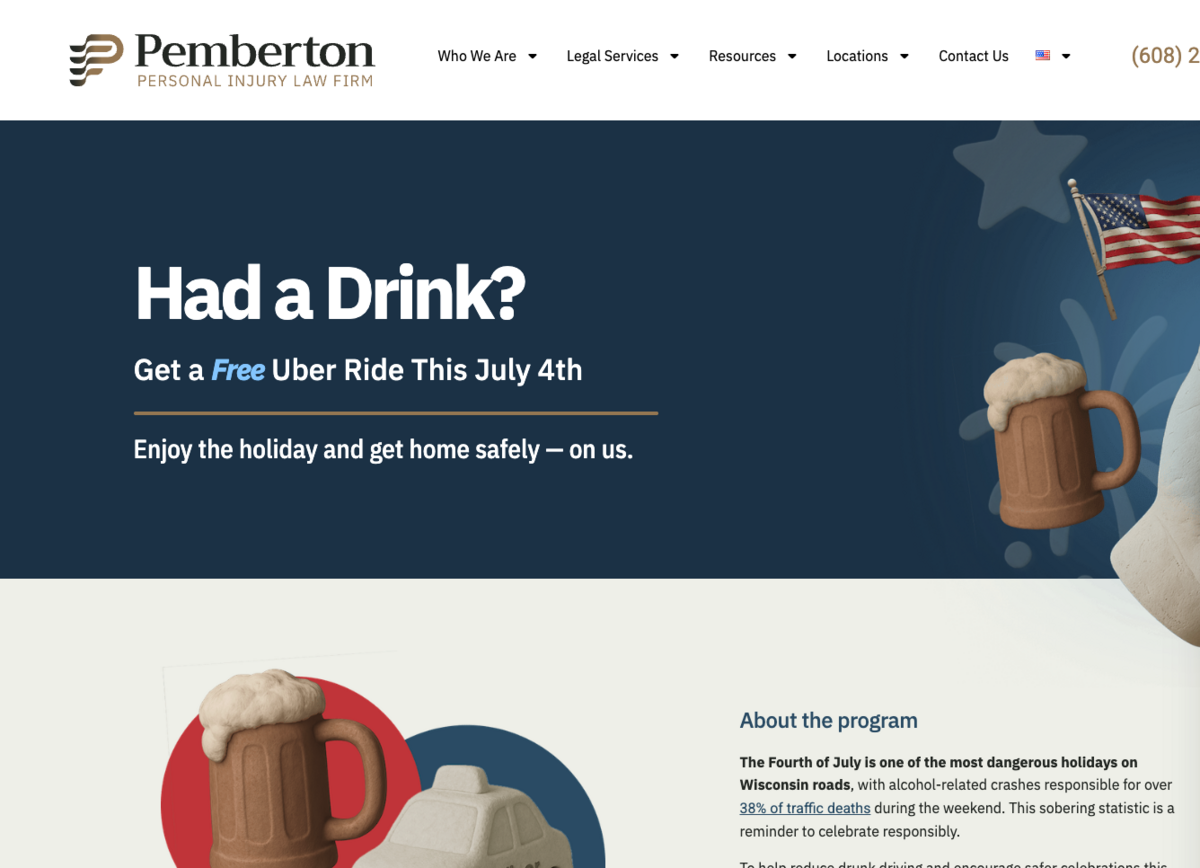
I spoke with Karla Fernandez, Digital PR Director with Onthemap.com, who spearheaded the campaign.
“Many of our clients are lawyers, home contractors, or medical professionals who depend on local visibility to drive new leads. For our client Pemberton Personal Injury Law Firm, we partnered with Uber for Business to provide free rides on the Fourth of July – one of the most dangerous holidays in the U.S., when alcohol-related crashes increase by nearly 40%.
The campaign struck a chord because it delivered real value to the community and an actionable solution to a major problem instead of being about self-promotion.
The best local sponsorships and activations are those that are highly relevant to your work and target causes that are timely, local, and helpful, making both the community and the media want to spread the word.”
Herald-Tribune Athlete of the Week
Another example I found was from the Central Florida Behavioral Health Network, Inc., which contracts with local community service organizations to help with mental health and substance use disorders.

They sponsor a weekly announcement from the Herald-Tribune in Sarasota, Florida, called the Herald-Tribune Girls Athlete of the Week.
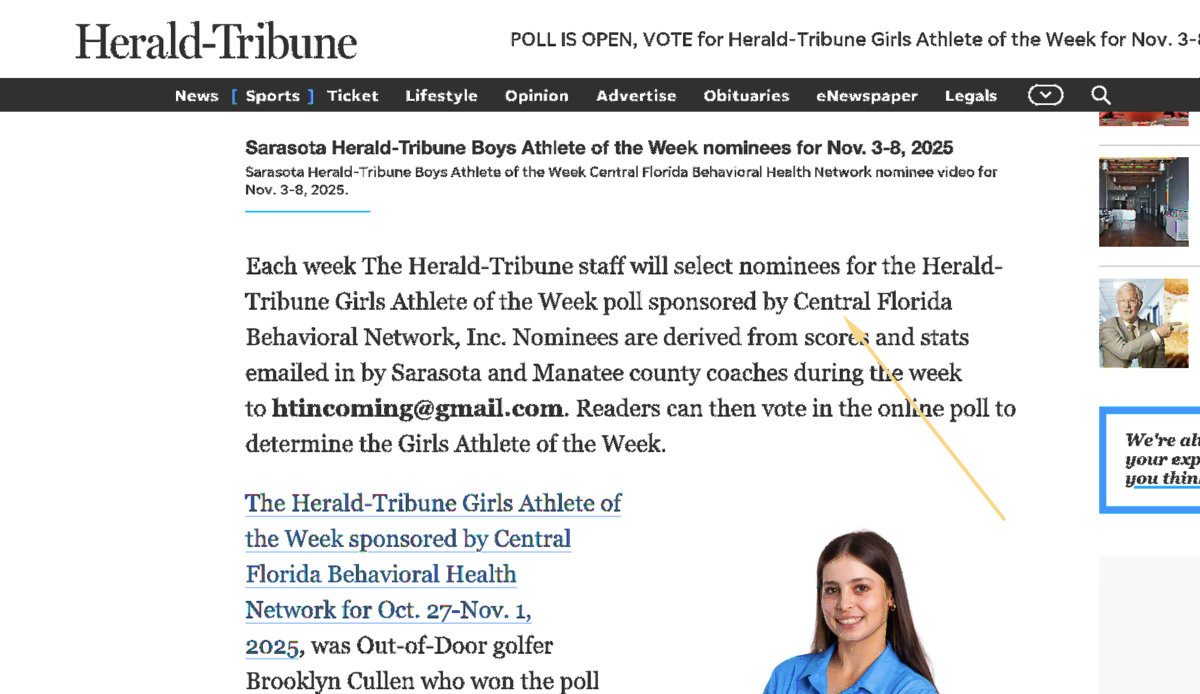
This is an interesting one because it is actually a partnership with the Herald-Times, which ensures that the Central Florida Behavioral Health Network gets a press mention each week.
The winners receive recognition on social media and the news (which I’m sure goes a long way towards their personal growth and potential scholarships), at the same time raise awareness for the Central Florida Behavioral Health Network.
Krumpe’s Do-nut Shop 5K
Another way to get your business in front of people is by sponsoring local events like races.
Krumpe’s Donut Shop in Hagerstown, MD, sponsors a 5K race.
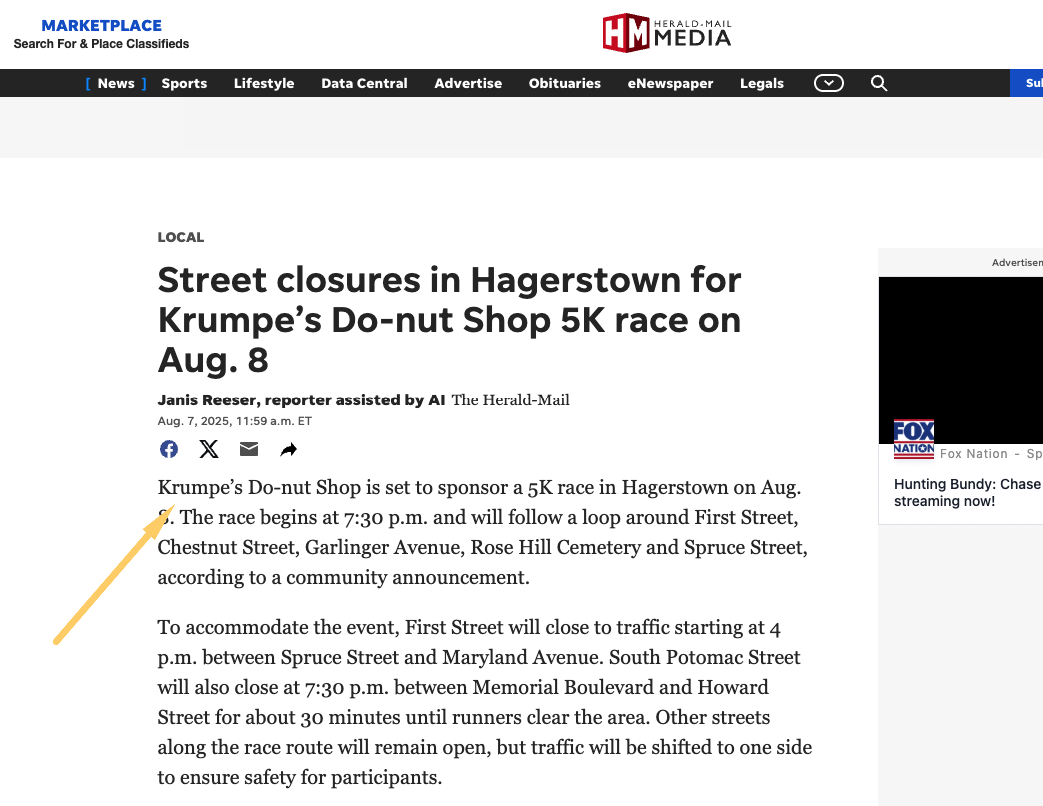
This yearly race gets them a lot of press mentions and links, but more importantly, it gets their product in front of (and in the belly of) their community.
Who doesn’t love a donut after a 5K?
How to do it
Lean on existing examples from the community for inspiration.
A simple Google News search for the term “sponsored by” can help you find local events in your community that are sponsored by different entities:
The most effective ways to collaborate are when you have a mix of audience relevance (your customers will also be interested in the event) and semantic relevance.
For instance, the Uber Rides offered by the personal injury lawyer mentioned above connect to the community but also connect to the business in that personal injury can occur from drunk driving.
Some brands take more creative liberties that stretch relevance.
For instance, the KSAN Collision of the Week segment covers big hits and “collisions” from local sports teams. Keating Paint and Body, an auto repair shop, sponsors it.
So, the collisions in question are by humans, not automobiles, but it’s a fun connection that still works.
And, at the end of the day, it probably reaches the right audience.
9. Consider Podcasts
Podcasts are an ever-growing source of citations as they continue to grow as a medium.
Not only can you pitch yourself or your client as a guest to get your brand out there, but podcasts can also become valuable sources of content if you choose to start one yourself.
We’ve covered this extensively in our post, so I won’t get too deeply into this here, but virtually every audience has a podcast these days.
For instance, if I owned a website that sold yarn or knitting supplies, Listen Notes says there are over 700 podcasts about knitting.

MoreBeer President on BeerSmith Podcast
Following my example above, here is a podcast where the president of MoreBeer, a website that sells home brewing supplies, Chris Graham, appears on a podcast called the BeerSmith Podcast.

Chris gets a mention on the site, but more importantly, he gets exposure with an extremely niche audience of potential home brewers.
BuzzStream Digital PR Podcast
I don’t normally like to insert our own examples in these posts, but the BuzzStream podcast was something I started early 2024.
At the time, there were more traditional PR podcasts but not very many “digital PR” podcasts out there.
So, I decided to create our own.

This not only gets BuzzStream directly in front of the kinds of customers we want, but it has also helped me build a lot of valuable relationships with potential future customers and thought leaders in the industry.
And podcast recording and editing software like Descript and Riverside has made the process extremely easy to produce a high-quality product.
How to do it:
To find relevant podcasts to pitch or podcast topics to start your, you can Google the topic + podcast and get a pretty good sense for what is out there.
The aforementioned Listen Notes is also a great podcast search engine.
Then, to pitch yourself as a guest, you’d want to find a topic that hasn’t been covered yet and pitch that. Include your credentials and specifically why you think their listeners would benefit from having you or your client as a guest.
Quality not Quantity
For a small business, it feels like you are putting out a lot of money to create and develop a survey campaign or sponsor a charity, but realistically, small businesses don’t need a lot of links to rank and show up in AI.
In fact, links are still among the biggest drivers of local searches.
Many may look for shortcuts and buying links. These are more costly than you might realize, and the gains are not what you’d expect. We conducted an extensive study of these link marketplaces and found that about 80% of the placements are of poor quality.
That said, as more and more studies come out, showing up in AI is less about backlinks; it’s all about brand mentions.
Think more about the story and less about the links and coverage.

 End-to-end outreach workflow
End-to-end outreach workflow



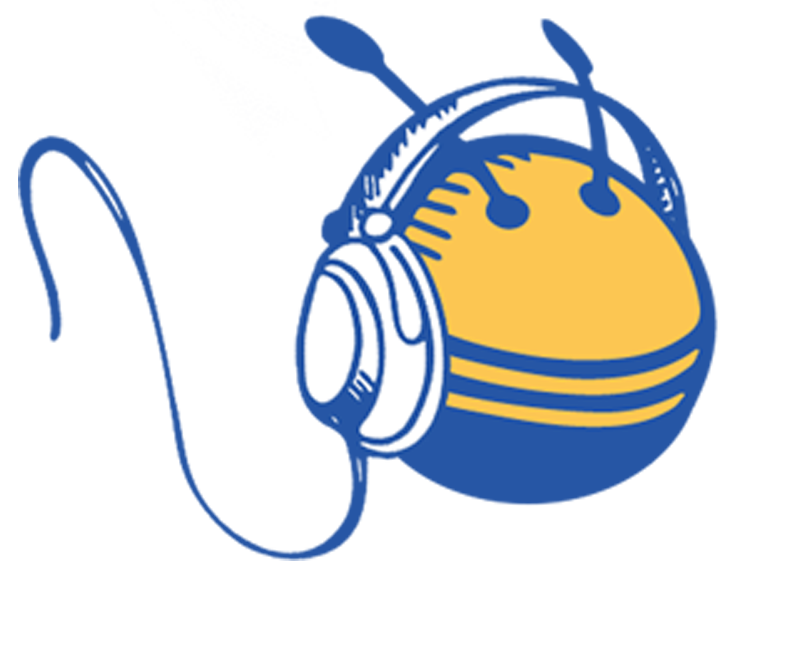 Check out the BuzzStream Podcast
Check out the BuzzStream Podcast







